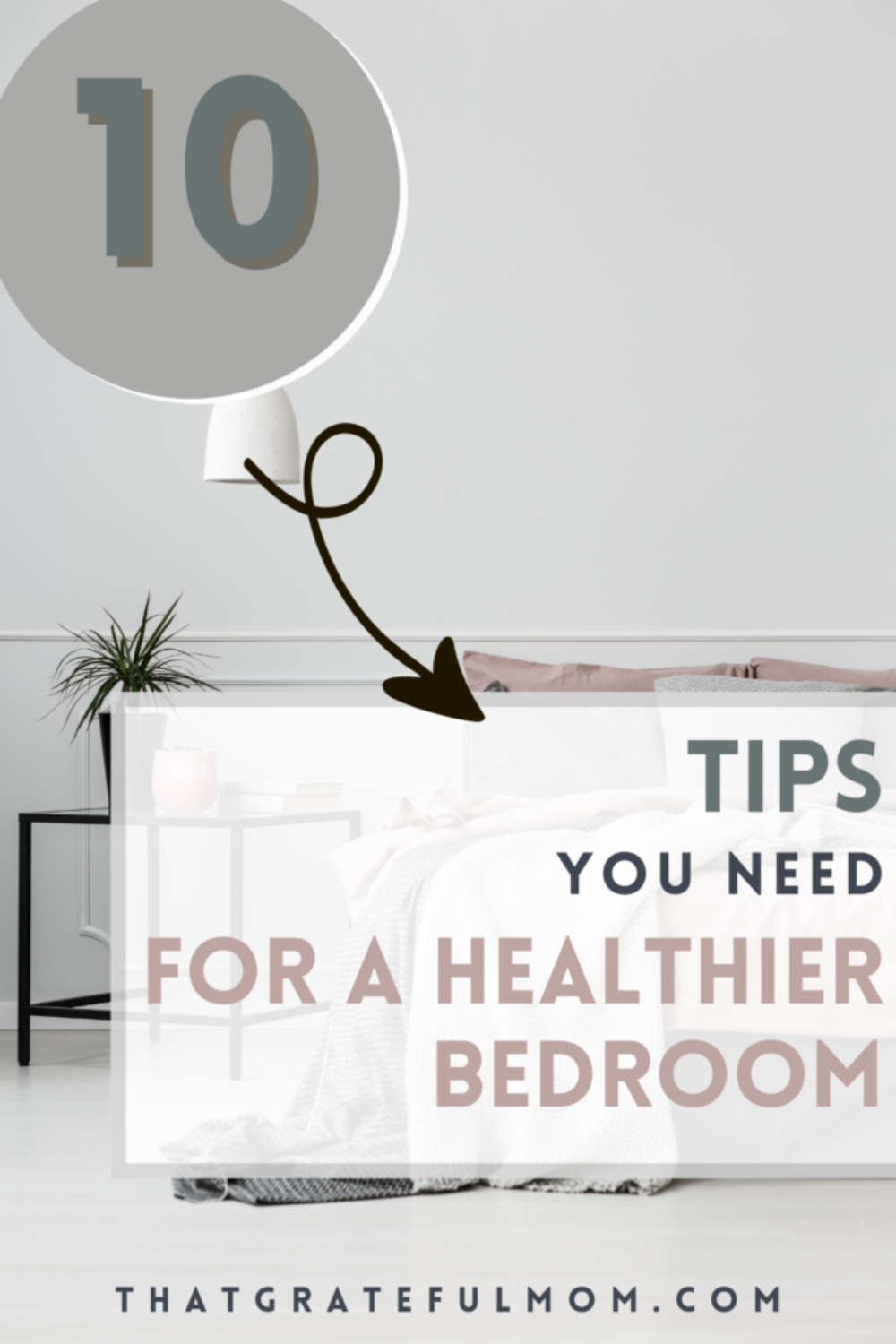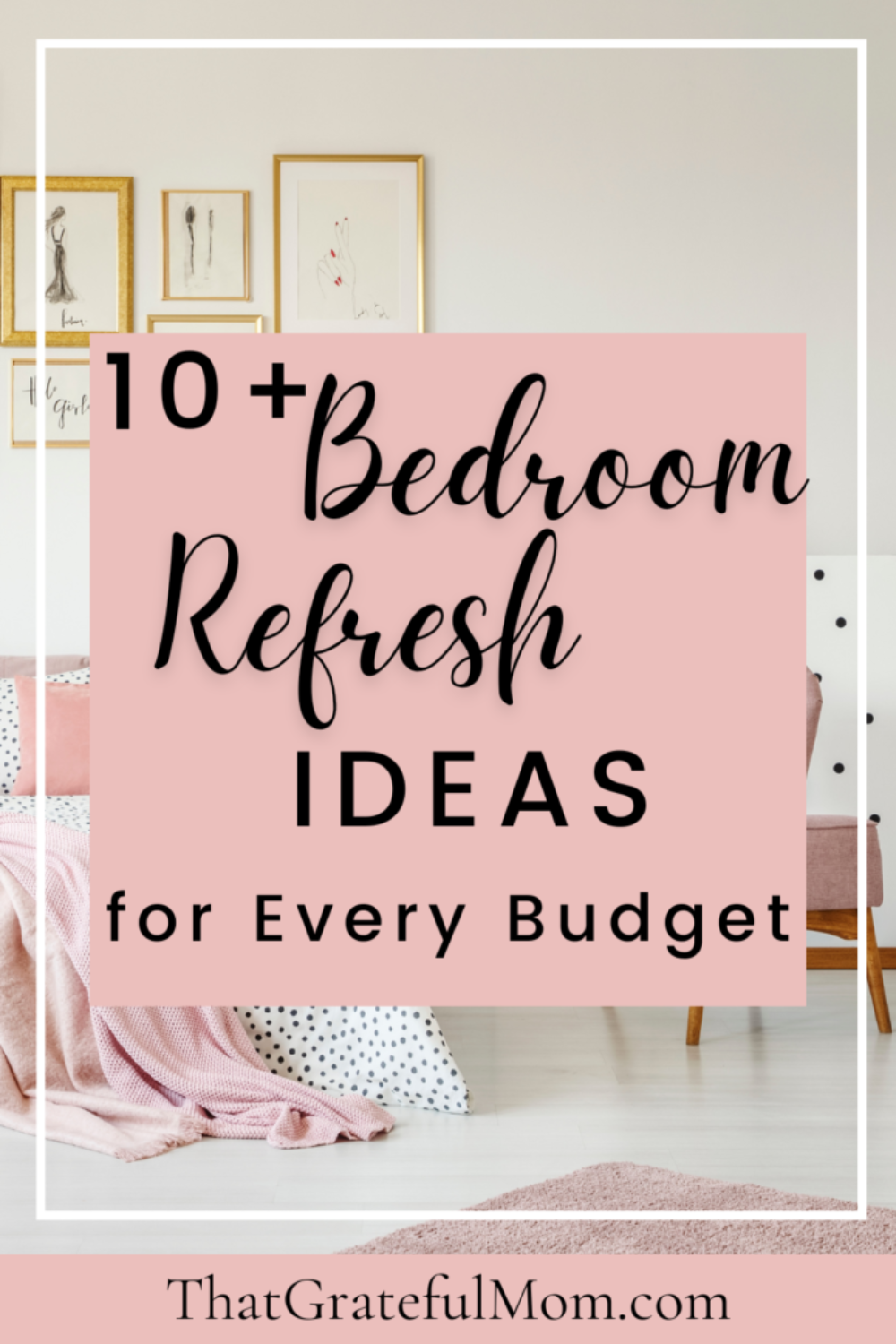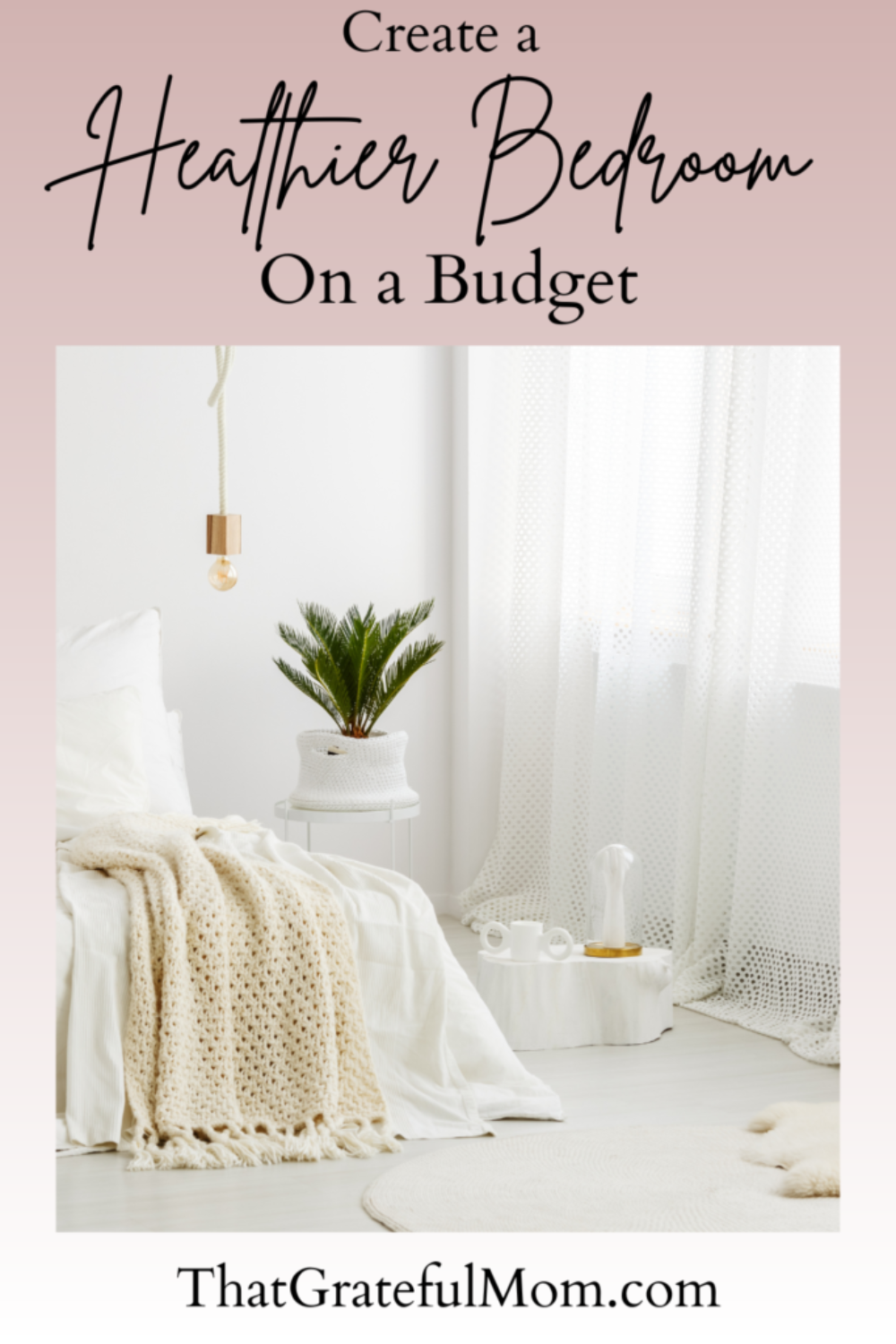Create a Healthier Bedroom with These Sleep-Friendly Tips
Did you know that we spend about one-third of our lives in our bedrooms? This makes it crucial to create a space that promotes not only top-notch sleep quality but also overall well-being. A healthier bedroom environment can significantly impact our circadian rhythm, stress levels, and physical and mental health. In this post, I’ll share simple and effective ways to transform your bedroom into a cozy space that encourages rest, relaxation, and a good night’s sleep.
Additionally, the tips shared today are budget-friendly, and easily achieved. As important as it is for us to make changes that encourage a healthier home, we also have to stick to our budget and make changes we can afford.
Many of the tips I’m sharing in today’s post can be applied to every area of your home, not just the bedrooms. If you’re working to shift your habits and embrace a more low-tox lifestyle, these swaps are an excellent starting point!
If you’re looking for more posts on low-tox living and simple swaps you can make in your home, here are some of my recent posts to help achieve those goals:

Optimizing Air Quality
Importance of Fresh Air
Creating a healthier bedroom starts with optimizing air quality. Breathing clean, fresh air is crucial for overall health and well-being, plus it encourages a restful sleep environment. Poor indoor air quality can exacerbate asthma and allergy symptoms, cause respiratory problems, and lead to frequent sleep disturbances during the night. Pollutants like dust mites, mold, pet dander, and volatile organic compounds (VOCs) from household products can accumulate indoors, making it essential to prioritize air quality in the bedroom. Ensuring that your bedroom has fresh air can help mitigate these risks and promote a healthier, more restful environment.
Ventilation
Proper ventilation is key to maintaining good air quality and encouraging a healthier bedroom. The good news is that this is easy to achieve with a few strategies:
- Open Windows: One of the simplest ways to improve ventilation is by opening your windows for a few hours each day. This allows fresh air to circulate and helps expel stale indoor air pollution. If outdoor pollution is a concern, try to open windows during times when air quality is better, such as early morning or late evening.
- Cross-Ventilation: Open windows on opposite sides of the room or house to create a cross-ventilation effect. This enhances airflow and helps replace indoor air with fresh outdoor air more effectively.
- Air Purifiers: If opening windows isn’t feasible due to outdoor pollution or weather conditions, consider using an air purifier. These devices can remove allergens, dust, and other pollutants from the air. Look for purifiers with HEPA air filters, which are highly effective at trapping small particles.
Here are a few of my favorite purifiers that we currently use throughout our home:
While Airdoctor is the most expensive brand I recommend, they often run incredible sales where you can get a purifier for free with your purchase. Their filters last around 6 or more months, helping to cut back on the cost of replacing filters. We saved and made sure to wait until they ran a sale and got 2 purifiers large enough to filter our entire home.
With over a dozen different options, Levoit offers an excellent variety of purifiers for every room in your home. They are very quiet, and their filters are affordable.
House plants
Introducing houseplants into your bedroom and home is a natural way to improve air quality in a budget-friendly way. Certain plants are particularly effective at filtering out harmful toxins and increasing oxygen levels. Just make sure to talk with your vet first if you have any pets, as some plants can be harmful if ingested. Here are a few recommendations:
- Snake Plant (Sansevieria): Known for its ability to convert CO2 into oxygen at night, the snake plant is ideal for bedrooms. It also filters out toxins like formaldehyde, xylene, and toluene.
- Spider Plant (Chlorophytum comosum): Easy to care for and excellent at removing common indoor pollutants such as formaldehyde and xylene, spider plants are great for improving air quality.
- Peace Lily (Spathiphyllum): Peace lilies are effective at removing toxins like ammonia, benzene, formaldehyde, and trichloroethylene from the air. They also add a touch of elegance to any room.
- Aloe Vera: Besides its air-purifying qualities, aloe vera is known for its healing properties. It helps remove formaldehyde and benzene, byproducts of chemical-based cleaners and paints.
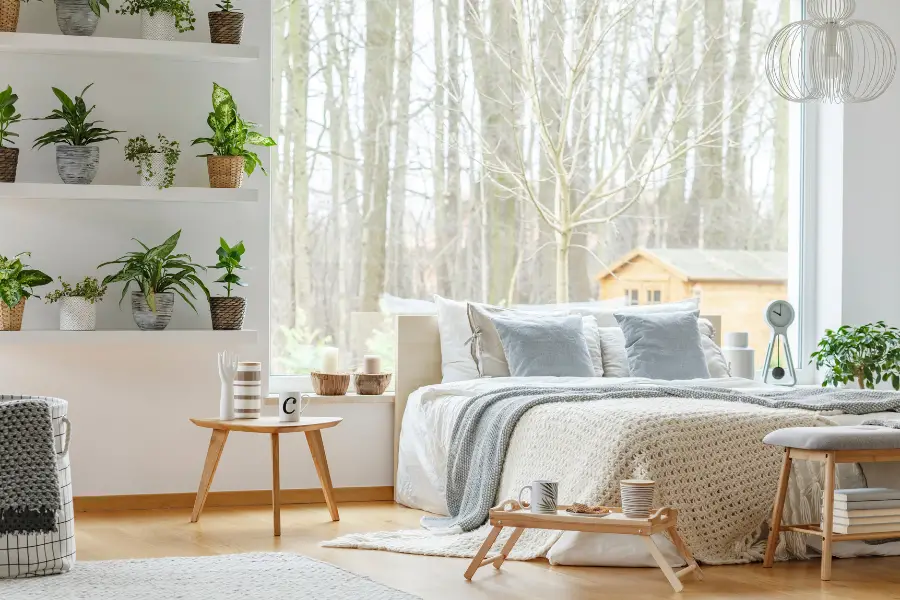
Avoiding Toxins
Be mindful of the materials used in your bedroom furnishings and cleaning products. Opt for non-toxic, eco-friendly options whenever possible to encourage a healthier bedroom. Here are some tips:
- Choose Natural Materials: Opt for furniture made from natural wood instead of particleboard, which can release toxic chemicals like formaldehyde, a harmful VOC. Natural materials are less likely to off-gas harmful chemicals.
- Eco-Friendly Paints: If you plan to repaint your bedroom, choose low-VOC paints or even VOC-free paints. These options release fewer toxic fumes into the air.
- Natural Cleaning Products: Use natural cleaning products to reduce the number of harmful chemicals in your bedroom. Many conventional cleaners contain harsh chemicals that can linger in the air and affect your respiratory health. Look for products labeled as eco-friendly or make your own cleaning solutions using ingredients like vinegar, baking soda, and essential oils. I’ve shared about non-toxic alternatives for all your favorite cleaning products here!
- Avoid Synthetic Fragrances: Many air fresheners, candles, and scented products contain synthetic fragrances that can emit harmful chemicals. Opt for natural alternatives like essential oil diffusers or candles made from soy or beeswax with natural fragrances.
Focusing on these areas can significantly improve the air quality in your home, creating a healthy bedroom that supports better sleep and overall well-being.
Lighting for Better Sleep
Creating a healthier bedroom environment involves optimizing your lighting, which plays a crucial role in regulating your sleep-wake cycle. Proper lighting can help you maintain a consistent circadian rhythm, making it easier to fall asleep, stay asleep, and wake up feeling refreshed.
Natural Light Exposure
Exposure to natural light during the day is essential for maintaining a healthy circadian rhythm. Our bodies rely on natural light cues to regulate sleep-wake cycles, which in turn improves sleep patterns. Instead of waking up and immediately grabbing your phone to start scrolling social media, get outside for a few minutes of morning sun.
Sunlight exposure helps regulate melatonin production, a hormone that controls sleep-wake cycles. Natural light exposure, especially in the morning, signals your body that it’s time to wake up and be alert.
If spending time outdoors isn’t feasible, ensure that your bedroom is well-lit with natural light during the day. Keep curtains or blinds open to let sunlight in. Position your bed near a window to maximize your exposure to natural light, especially in the morning.
Lighting Choices
In the evening, the type of artificial light you use can significantly impact your ability to fall asleep. As bedtime approaches, switch to softer, warmer lighting. Harsh, bright lights can interfere with the production of melatonin, the hormone that signals to your body that it’s time to sleep. Use dimmable lamps or install bulbs that emit a warm, amber glow to create a calming atmosphere in your bedroom.
Additionally, incorporate layered lighting in your bedroom to provide flexibility. Adjust the lighting according to your needs throughout the evening using a combination of overhead lights, bedside table lamps, and floor lamps.
Blue Light Reduction
Blue light emitted by electronic devices like cell phones, tablets, and computers can disrupt your sleep by suppressing melatonin production. They can also negatively affect your health by causing dizziness and headaches. Reducing blue light exposure in the evening is crucial for better sleep. Here are some simple changes to make in your evening routine:
- Device-Free Hour: Aim to avoid using electronic devices at least an hour before bed. This break from screens helps your body wind down and signals that it’s time to prepare for sleep.
- Blue Light Filters: If avoiding screens isn’t possible, consider using blue light filters or glasses designed to block blue light. These tools can help reduce the impact of blue light on your sleep.
- Night Mode Settings: Many devices have night mode settings that reduce blue light emissions by shifting the display to warmer tones. Activate these settings in the evening to minimize blue light exposure.
Using Blackout Curtains
Blackout curtains are a simple yet effective way to improve sleep quality by controlling the amount of light that enters your bedroom. These curtains are designed to block out external light sources that can make it difficult to sleep deeply. This is especially beneficial if you live in an area with significant light pollution or if you need to sleep during the day, such as for shift workers.
Here are some excellent options that are clean and affordable:

Implementing Lighting Changes
Here’s a simple routine to follow to encourage proper lighting throughout the day:
- Morning Routine: Start your day by opening your curtains or blinds to let in natural light. If possible, spend some time outside in the morning sunlight to help set your circadian rhythm.
- Evening Routine: Gradually dim the lights in your home as the evening progresses. Use lamps with warm, amber bulbs in the hours leading up to bedtime to create a relaxing atmosphere.
- Bedroom Setup: Position your bed near a window to maximize exposure to natural light during the day. At night, use blackout curtains to block out any disruptive light.
- Tech Management: Reduce screen time before bed, use blue light filters, and activate night mode settings on your devices. Create a tech-free zone to encourage better sleep habits and create a healthier bedroom.
Noise Control
Impact of Noise on Sleep
Creating a peaceful and quiet bedroom environment is essential for achieving restful and uninterrupted sleep. Noise pollution, whether from a busy road, neighbors, or household sounds, is a common disruptor of sleep. Addressing noise issues can lead to better sleep quality and overall well-being.
Persistent noise can elevate stress and anxiety levels, making it harder to fall asleep and stay asleep, leading to health concerns like increased heart rate, blood pressure, and even a weakened immune system. Here are some tips to help encourage a better night’s sleep:
Seal gaps around doors and windows
Sometimes soundproofing is as simple as sealing any gaps you may notice around windows and doors. This will help prevent excess noise from keeping you awake throughout the night.
Soundproof
Use heavy curtains or thick rugs to reduce the level of noise in your bedroom. Both can help filter out noise pollution and encourage more restful sleep. Make sure they are made from natural fibers and not treated with harsh chemicals.
White noise machine
White noise machines generate soothing background noise that can mask disruptive sounds. Many people find the consistent hum of white noise to be calming and conducive to sleep. Choose an option that does not emit EMFs, as this can lead to sleep disturbances.
Bedding
Creating a comfortable and supportive sleeping environment begins with choosing the right bedding. The quality of your mattress, pillows, and bed linens can significantly impact your sleep quality and overall health.
If feasible, tossing your old mattress and investing in a low-tox alternative is an incredible way to create a healthier bedroom. Flame retardants, formaldehyde, benzene, and VOCs found in conventional mattresses can cause a slew of health issues, including respiratory distress, allergic reactions, and cancer. It’s frustrating that this is the norm instead of organic, simple ingredients. When researching organic alternatives, consider things like the mattress’s ingredients and the brand’s transparency.
Trustworthy, low-tox mattress brands:
If purchasing a new mattress is out of the question, don’t fret. I understand that this is not in everyone’s budget. Ranging in price from $800 to upwards of $4,000, they aren’t exactly affordable. Remember to do what you can and consider a mattress topper instead. This helps ensure you are another layer away from the actual mattress, plus it protects the mattress from any spills.
Mattress Pads:
If the price of a mattress topper is still out of the question, that’s okay, too. Add it to your list of eventual goals, and keep moving forward. Organic bedding is a great alternative that is even more affordable while still helping to protect you and your family from the chemicals in conventional mattresses.
Affordable, low-tox linen brands:
Another product to research is the pillows you use. Like mattresses, conventional pillows contain flame-retardant chemicals and other toxic ingredients that can cause skin irritation, respiratory distress, and cancer. When shopping for new pillows, opt for breathable, natural materials like cotton, linen, or bamboo. These fabrics help regulate body temperature and wick away moisture, keeping you comfortable throughout the night. High-quality bedding can enhance your sleep experience and contribute to a healthier sleeping environment.
Whether you’re a back, front, or side sleeper, there are affordable alternatives available.
Low-toxic pillow brands:
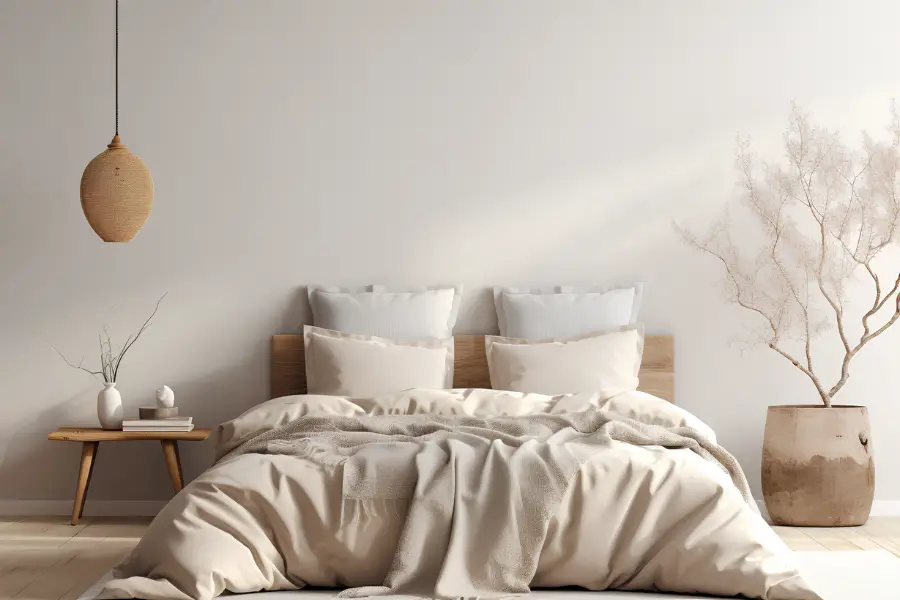
Decluttering and Organization
A clutter-free bedroom promotes a sense of calm and can significantly improve your sleep quality. Keeping your personal space tidy and organized reduces visual distractions, making it easier to unwind and prepare for a good night’s sleep.
Decluttering tips
Start by sorting through your belongings and deciding what to keep, donate, or discard. Here are some steps to help you get started:
- Set a goal: Decide which areas of your bedroom you want to tackle first. Breaking the task into smaller sections can make it more manageable.
- Sort items: Go through your belongings and sort them into categories: keep, donate, and discard. Focus on keeping items that you love and use regularly.
- Organize as you go: As you sort, start organizing items into designated spaces. Use storage solutions such as bins, baskets, and shelves to keep everything in order.
Organization options
- Utilize the space under your bed for items you don’t need frequently. This keeps things out of sight but easily accessible.
- Maximize closet space with organizers such as hanging shelves, shoe racks, and drawer dividers.
- Make decluttering a regular habit. Spend a few minutes each day tidying up and putting items back in their designated places. Regular maintenance can prevent clutter from building up and help you maintain an organized, restful bedroom.
Clean your space often
The best way to create a healthier bedroom and home is to clean regularly. A clean and organized bedroom not only looks inviting but also promotes a relaxing and restful environment. Regular cleaning helps eliminate dust, allergens, and clutter, all of which can interfere with sleep quality and overall health.
To maintain a clean and relaxing bedroom, consider implementing the following cleaning routines:
- Daily Tidying: Spend a few minutes each day tidying up your bedroom. Make your bed each morning, put away clothes, and clear any surfaces of clutter. Keeping up with daily tasks prevents mess from accumulating.
- Weekly Cleaning: Dedicate time each week to perform a more thorough cleaning. Dust all surfaces, vacuum or sweep the floors, and change your bed linens. Pay special attention to areas that collect dust, such as shelves, windowsills, and under the bed.
- Monthly Deep Cleaning: Perform a deep cleaning of your bedroom once a month. This includes washing curtains, cleaning windows, wiping down baseboards, and organizing closets and drawers. Deep cleaning helps address areas that may be overlooked in regular cleaning routines.
Temperature Regulation
Maintaining an optimal bedroom temperature is crucial for ensuring a good night’s sleep. The right temperature can help your body prepare for sleep and stay asleep throughout the night and significantly affect your sleep quality. Studies suggest that the ideal sleeping temperature is typically between 60-67° degrees Fahrenheit as this range helps lower your body’s core temperature, which is essential for falling asleep and staying asleep. To maintain an optimal sleeping temperature, consider implementing the following tips:
- Use Fans or Air Conditioners: In the summer months, keep your bedroom cool with fans or air conditioners. Fans can help circulate air and create a cooling breeze, while air conditioners can maintain a consistent temperature.
- Heaters and Extra Blankets: In the winter, use heaters or extra blankets to keep your bedroom warm. Layer your bedding, as this allows you to adjust your comfort level easily. Use a combination of sheets, blankets, and comforters so you can add or remove layers as needed.
Final Thoughts
Creating a healthier bedroom doesn’t have to be complicated or expensive. By making a few simple changes, you can transform your sleeping environment into a sanctuary that promotes rest and rejuvenation. Implement these habits into your daily life, and continue these changes in the rest of your home by adding plants in your living room, non-toxic air fresheners in the bathroom, and creating a calming environment in every room of your home.
This site may contain links to affiliate websites including Amazon. I may receive an affiliate commission for any purchases made by you through Amazon or other potential affiliates and no additional cost to you. Thank you for your support.


